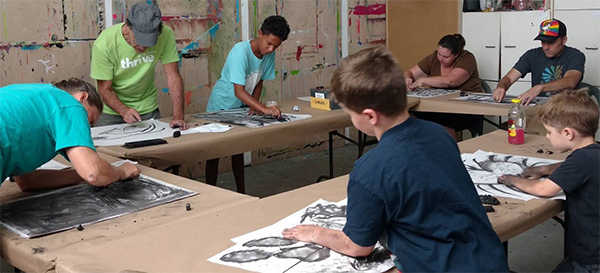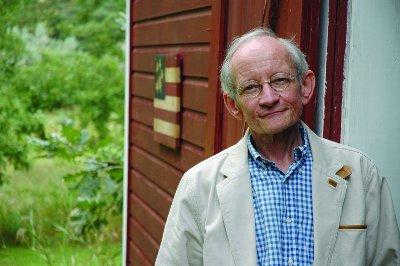- Editor
- Posted On
Friday, 09 May 2025
Arts & Life
- Editor
- Posted On
Wine studio hosts Aug. 6 art class
The August wine and art session with Sabalone is scheduled for Sunday, Aug. 6, and will focus on painting a scene of irises in watercolors.
The class will take place from 1:30 to 4 p.m.
The class fee of $40 covers all of the provided art supplies needed along with step-by-step guidance and a glass of Lake County wine.
Reservations are required for each month's class as participation is limited to 12 people.
Sabalone was born and raised in Lake County. She has been involved in the Lake County Arts Council since her teen years.
She attended the University of California, Santa Barbara and the University of Leeds, England for her undergraduate degree in English, history and anthropology.
She earned her teaching credential and Masters of Education from UCSB and has been teaching art, English, history and academic decathlon at Upper Lake High School since 2008.
For class schedule, reservations and additional information, contact Susan Feiler at 707-293-8752.
The Lake County Wine Studio is both a gallery for display of arts and a tasting room, wine bar and retail shop for the fine wines of Lake County. Artists’ shows are held on a monthly basis with art and wine receptions held the first Friday and subsequent Saturday of each month.
The gallery is located at 9505 Main St. in Upper Lake. It’s open Thursday through Monday, 1 to 7 p.m. and Friday from 1 to 8 p.m.
For more information call the studio at 707-275-8030.
- Editor
- Posted On
Middletown Art Center hosts ‘Community Works 2.0’ low-cost art classes from July 26 to Aug. 6

MIDDLETOWN, Calif. – The Middletown Art Center is offering “Community Works 2.0” July 26 through Aug. 6.
Get out of the heat and get cool and creative! Engage in artistic fun or perhaps process lingering trauma and fear during this fire season.
There are separate classes for adults and children, and classes for adults and children together.
Most classes are $5 to $10 per person on a sliding scale, with a few classes that require more materials and lengthier time costing $15. No one will be turned away for lack of funds.
MAC encourages family members and favorite adults to accompany children and enjoy spending time together making art.
Classes in painting, collage/mixed media, and printmaking are offered this Wednesday, July 26, through Friday, July 28, and watercolors is offered Tuesday, Aug. 1. Each class is appropriate for both children and adults.
Sunday, July 30, is the tie dye playshop, which is appropriate for all ages. An adult or older sibling must accompany children under 10. They will be using fine dyes, and colors that can be mixed to achieve unique designs. The fee for this class is $15, or $10 if you bring your own t-shirt or other garment to tie dye.
Classes that are tailored for adults and teens include Sweat Your Prayers, dance on Friday evening, July 28; open session life drawing (no instructor), and assemblage or altered art – a collage of found objects, both offered on Saturday, July 29.
A second assemblage class geared to more sculptural pieces is offered Sunday, Aug. 6.
Participants are invited to bring their own meaningful objects, including remnants from the fire.
The fee for assemblage and life drawing is $15. Photographing Resilience is offered for $5, on Saturday, Aug. 5.
Please visit http://www.middletownartcenter.org/classes.html for more details and to preregister, so that they are ready for you.
The Middletown Art Center is a nonprofit arts organization created by community for community. MAC is dedicated to providing artistic and cultural opportunities to residents and visitors of Lake County while contributing to local community and economic vitality. Support MAC through memberships with benefits, or tax deductible donations. All donations are greatly appreciated and help grow and sustain the arts in Lake County.
- Elizabeth Larson
- Posted On
First Friday Fling takes place Aug. 4
- Tim Riley
- Posted On
Taut war action of ‘Dunkirk’ highlights heroic survival
DUNKIRK (Rated PG-13)
British director Christopher Nolan, acclaimed filmmaker of “The Dark Knight” trilogy and “Inception” among others, has created a masterpiece of wartime survival based upon a crucial chapter in the history of World War II in the epic “Dunkirk.”
At the outset of “Dunkirk,” the credits make it clear this is more than a war film, noting that the Allied forces were surrounded by the German army on the beaches of the French coastal city, merely 26 miles away from Great Britain, separated by the seas of the English Channel.
Yet for approximately 400,000 British and Allied forces, including French, Canadian and Belgian soldiers, survival was very much in doubt as air bombardments from the Luftwaffe threatened to sink all ships. The troops were hoping for deliverance and a miracle.
In late May 1940, the outcome of the war on the European front was very much in doubt even before the United States entered the fray in December 1941, when days after Pearl Harbor the Germans declared war on us.
History could have been quite different without the successful rescue operation at Dunkirk. Nolan effectively captures the precarious nature of the evacuation that occurred over the course of more than an intense week.
The structure of “Dunkirk” is fascinating in its execution. Three parallel stories are woven into one central theme. A battle in the air is short-lived, the flotilla of rescue boats occupies a day and the evacuation on the beachfront lasts more than a week.
If “Dunkirk” has one character to serve as the Everyman, it could fall to British soldier Tommy (Fionn Whitehead) who barely survives enemy fire in a neighboring town only to find himself stranded on the Dunkirk beach with hundreds of thousands awaiting their fate.
It’s through Tommy’s experiences, either trying to get a wounded soldier onto a Red Cross hospital ship that is soon bombed by the Germans or holed up with other scared young soldiers in the hull of a boat full of leaks, that we see the harrowing ordeal of the evacuation.
Meanwhile, as naval Commander Bolton (Kenneth Branagh) and ranking Army officer Colonel Winnant (James D’Arcy) organize the logistics of boats and ships docking in the challenging shallow waters, the RAF Spitfires offer the only credible line of defense.
A few hardy fighter pilots take on the superior German airpower with brilliantly staged dogfights over the English Channel. The director’s keen sense of realism shows how difficult it is to align an enemy target for a direct hit with machine gun fire in tight aerial engagements.
The senior RAF pilot is Farrier (Tom Hardy), who turns out to be the heart and soul of the aerial dogfights as he defies the logistics of fuel capacity to continue the fight until he can no longer safely return to the home base.
The interesting thing about the pilots is that their heroism is realized only by restricted movements in small cockpits with just expressive looks hidden mostly behind protective masks. Tom Hardy has carried this off before as the masked Bane in a Nolan-directed “Batman” film.
Back in coastal England, a flotilla of pleasure craft and small boats are recruited from private citizens to undertake a seagoing rescue. Mark Rylance’s Mr. Dawson, motivated by patriotism, steers his small boat across the Channel with help from his son and another teen boy.
If Tommy stands for the everyday soldier, then Mr. Dawson is the embodiment of the citizen effort at sea. His journey is not without peril or added tension when he rescues a shell-shocked sailor (Cillian Murphy) who is adamantly opposed to returning to the battle scene.
On the whole “Dunkirk” is an ensemble film, even if standout performances come from young Fionn Whitehead and the middle-aged Mark Rylance. In any case, it’s a story told mostly through action and not an excessive amount of dialogue or any backstory.
On June 4, 1940, in the wake of the Dunkirk evacuation, Prime Minister Winston Churchill gave his famous speech in the House of Commons, in which he said England would fight on the beaches, in the hills and that surrender was never an option.
Churchill needed his nation to know that the war effort raged on, observing in this speech that England “must be very careful not to assign to this deliverance the attributes of a victory. Wars are not won by evacuations.”
In “Dunkirk,” Nolan captures the spirit of heroic acts, whether it’s from the RAF Spitfire pilots fighting until their fuel runs out or ordinary citizens entering the dangerous mission with pleasure craft to rescue stranded soldiers.
The feeling that a turning point in the war has been realized with the Dunkirk operation is a palpable sign of hope for a future free of the oppression that would surely have come with a victory by Nazi Germany so early in the war.
“Dunkirk” just might be a film for the ages, a serious-minded effort that defies the usual escapist fare that dominates the summer box office.
This is about heroism, though often nuanced by human errors, without silly capes and super powers.
Tim Riley writes film and television reviews for Lake County News.
- Ted Kooser
- Posted On
American Life in Poetry: Bowling in Heaven

LCNews
Responsible local journalism on the shores of Clear Lake.
Memberships:
 |
 |
 |
 |
 |
 |

